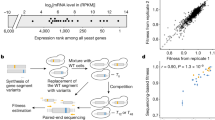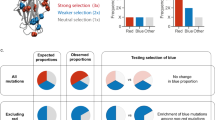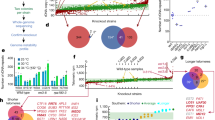Abstract
Deep sequencing can accurately measure the relative abundance of hundreds of mutations in a single bulk competition experiment, which can give a direct readout of the fitness of each mutant. Here we describe a protocol that we previously developed and optimized to measure the fitness effects of all possible individual codon substitutions for 10-aa regions of essential genes in yeast. Starting with a conditional strain (i.e., a temperature-sensitive strain), we describe how to efficiently generate plasmid libraries of point mutants that can then be transformed to generate libraries of yeast. The yeast libraries are competed under conditions that select for mutant function. Deep-sequencing analyses are used to determine the relative fitness of all mutants. This approach is faster and cheaper per mutant compared with analyzing individually isolated mutants. The protocol can be performed in ∼4 weeks and many 10-aa regions can be analyzed in parallel.
This is a preview of subscription content, access via your institution
Access options
Subscribe to this journal
Receive 12 print issues and online access
$259.00 per year
only $21.58 per issue
Buy this article
- Purchase on Springer Link
- Instant access to full article PDF
Prices may be subject to local taxes which are calculated during checkout




Similar content being viewed by others
References
Hietpas, R.T., Jensen, J.D. & Bolon, D.N. Experimental illumination of a fitness landscape. Proc. Natl. Acad. Sci. USA 108, 7896–7901 (2011).
Pool, J.E., Hellmann, I., Jensen, J.D. & Nielsen, R. Population genetic inference from genomic sequence variation. Genome Res. 20, 291–300 (2010).
Jensen, J.D., Wong, A. & Aquadro, C.F. Approaches for identifying targets of positive selection. Trends Genet. 23, 568–577 (2007).
Hegreness, M., Shoresh, N., Hartl, D. & Kishony, R. An equivalence principle for the incorporation of favorable mutations in asexual populations. Science 311, 1615–1617 (2006).
Lind, P.A., Berg, O.G. & Andersson, D.I. Mutational robustness of ribosomal protein genes. Science 330, 825–827 (2010).
Smith, J.M. & Haigh, J. The hitch-hiking effect of a favourable gene. Genet. Res. 23, 23–35 (1974).
Giaever, G. et al. Functional profiling of the Saccharomyces cerevisiae genome. Nature 418, 387–91 (2002).
Weinreich, D.M., Delaney, N.F., Depristo, M.A. & Hartl, D.L. Darwinian evolution can follow only very few mutational paths to fitter proteins. Science 312, 111–114 (2006).
Lenski, R.E. Quantifying fitness and gene stability in microorganisms. Biotechnology 15, 173–192 (1991).
Cunningham, B.C. & Wells, J.A. High-resolution epitope mapping of hGH-receptor interactions by alanine-scanning mutagenesis. Science 244, 1081–1085 (1989).
Fowler, D.M. et al. High-resolution mapping of protein sequence-function relationships. Nat. Methods 7, 741–746 (2010).
Pitt, J.N. & Ferre-D'Amare, A.R. Rapid construction of empirical RNA fitness landscapes. Science 330, 376–379 (2010).
Ernst, A. et al. Coevolution of PDZ domain-ligand interactions analyzed by high-throughput phage display and deep sequencing. Mol. Biosyst. 6, 1782–1790 (2010).
Wach, A., Brachat, A., Pohlmann, R. & Philippsen, P. New heterologous modules for classical or PCR-based gene disruptions in Saccharomyces cerevisiae. Yeast 10, 1793–1808 (1994).
Tsalik, E.L. & Gartenberg, M.R. Curing Saccharomyces cerevisiae of the 2 micron plasmid by targeted DNA damage. Yeast 14, 847–852 (1998).
Guthrie, C. & Fink, G.R. Guide to Yeast Genetics and Molecular and Cell Biology Vol. 350, Part B (Methods in Enzymology) (Academic Press, 2002).
Gietz, R.D., Schiestl, R.H., Willems, A.R. & Woods, R.A. Studies on the transformation of intact yeast cells by the LiAc/SS-DNA/PEG procedure. Yeast 11, 355–360 (1995).
Gietz, R.D. & Schiestl, R.H. Large-scale high-efficiency yeast transformation using the LiAc/SS carrier DNA/PEG method. Nat. Protoc. 2, 38–41 (2007).
Scanlon, T.C., Gray, E.C. & Griswold, K.E. Quantifying and resolving multiple vector transformants in S. cerevisiae plasmid libraries. BMC Biotechnol. 9, 95 (2009).
Johnston, M. & Davis, R.W. Sequences that regulate the divergent GAL1-GAL10 promoter in Saccharomyces cerevisiae. Mol. Cell Biol. 4, 1440–1448 (1984).
Cock, P.J., Fields, C.J., Goto, N., Heuer, M.L. & Rice, P.M. The Sanger FASTQ file format for sequences with quality scores, and the Solexa/Illumina FASTQ variants. Nucleic Acids Res. 38, 1767–1771 (2009).
Fowler, D.M., Araya, C.L., Gerard, W. & Fields, S. Enrich: software for analysis of protein function by enrichment and depletion of variants. Bioinformatics 27, 3430–3431 (2011).
Pitt, J.N., Rajapakse, I. & Ferre-D'Amare, A.R. SEWAL: an open-source platform for next-generation sequence analysis and visualization. Nucleic Acids Res. 38, 7908–7915 (2010).
Acknowledgements
This work was supported in part by grants from the US National Institutes of Health (R01-GM083038) and the American Cancer Society (RSG-08–17301-GMC) to D.N.A.B.
Author information
Authors and Affiliations
Contributions
R.H., B.R., L.J. and D.N.A.B. all contributed to the development and optimization of the protocol and writing the article. R.H. prepared the initial draft for the section on generating mutant libraries. B.R. prepared the initial draft for the section on growth competition. B.R. and L.J. prepared the initial draft for the section on preparing samples for deep sequencing. D.N.A.B. prepared the initial draft for the section on processing sequencing data. D.N.A.B. supervised the work and prepared the final version of the manuscript.
Corresponding author
Ethics declarations
Competing interests
The authors declare no competing financial interests.
Supplementary information
Supplementary Fig. 1
Features and sequence of bacterial-yeast shuttle plasmid pRNDM. This plasmid was derived from pRS414 with the tryptophan marker replaced by KanMX4 and the beta-lactamase gene removed. (PDF 48 kb)
Rights and permissions
About this article
Cite this article
Hietpas, R., Roscoe, B., Jiang, L. et al. Fitness analyses of all possible point mutations for regions of genes in yeast. Nat Protoc 7, 1382–1396 (2012). https://doi.org/10.1038/nprot.2012.069
Published:
Issue Date:
DOI: https://doi.org/10.1038/nprot.2012.069
This article is cited by
-
Inferring the distribution of fitness effects in patient-sampled and experimental virus populations: two case studies
Heredity (2022)
-
MaveDB: an open-source platform to distribute and interpret data from multiplexed assays of variant effect
Genome Biology (2019)
-
The fitness landscape of the codon space across environments
Heredity (2018)
-
Correlation of fitness landscapes from three orthologous TIM barrels originates from sequence and structure constraints
Nature Communications (2017)
-
Detection and sequence/structure mapping of biophysical constraints to protein variation in saturated mutational libraries and protein sequence alignments with a dedicated server
BMC Bioinformatics (2016)
Comments
By submitting a comment you agree to abide by our Terms and Community Guidelines. If you find something abusive or that does not comply with our terms or guidelines please flag it as inappropriate.



